Recollections of The Pine Barrens Protection Act’s 30th Anniversary
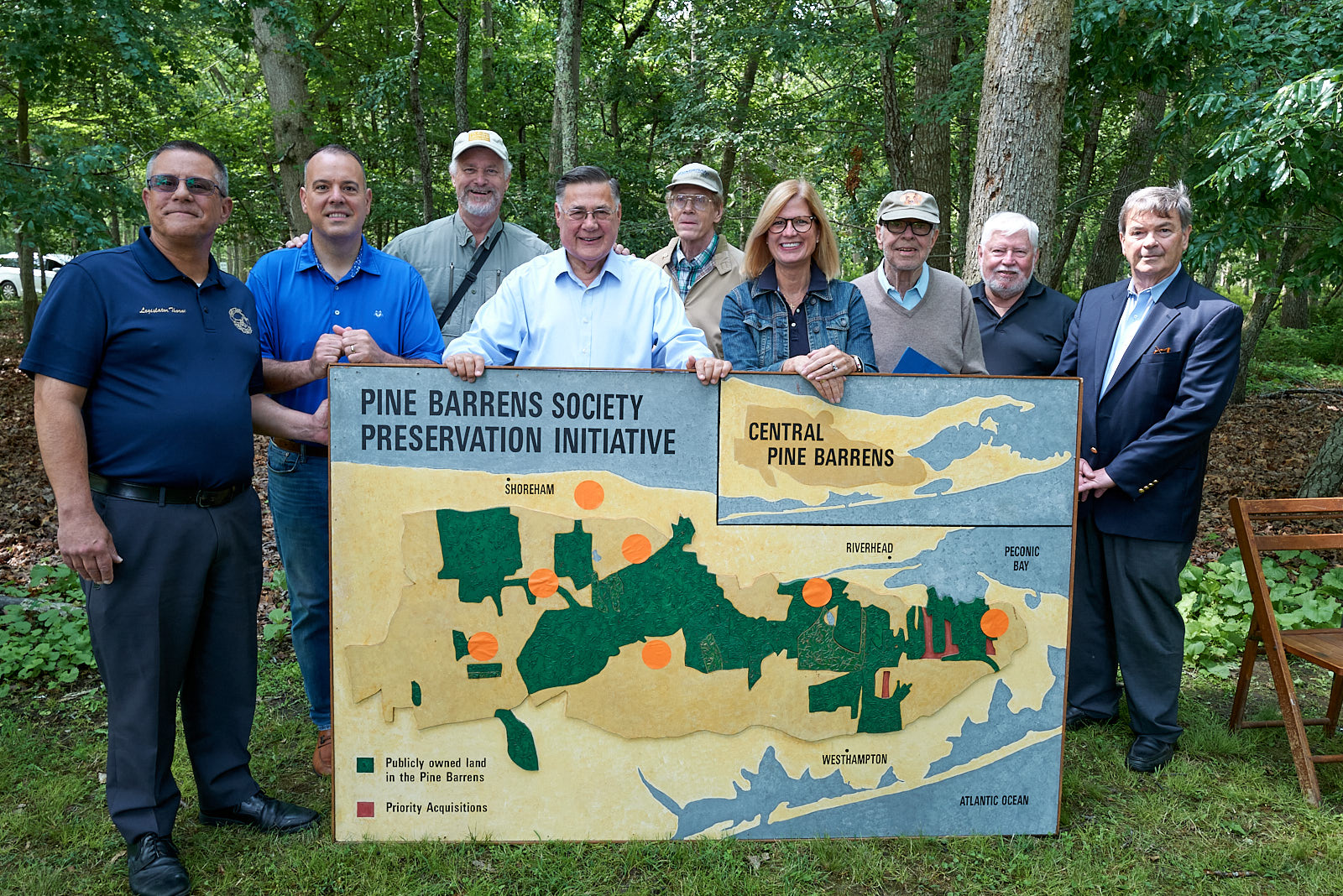
Last Saturday, June 17, the Long Island Pine Barrens Society packed their cars full of tents and posters, and made their way to Southaven County Park, where a very special celebration was held. The tents were built, and posters placed, a single podium was the center of attention, as a long banner was strung between two trees behind it. Slowly, the chairs behind the podium were filled with representatives from all across the county, and by the time 10AM came around, the stage was set for the Pine Barrens Protection Act’s 30th Anniversary.
The event, much like the act it commemorated, was in turmoil all the way up until the morning it was meant to take place. The forecast called for thunderstorms starting at the very moment the celebration would have begun, and the night before was fraught with anxiety over how the event would be held in a downpour. Despite that though, the weather on the day of the event was some of the best we’d had that week; clear skies and chirping birds made the atmosphere perfect for the commemoration taking place.

Photo by Wayne Cook
The day opened with a short speech from our Executive Director Dick Amper, offering a retrospective of what it took to make it to this point, through all the work that spanned not just the last 30 years, but the society’s entire existence. After he stepped away from the podium, Amper was quickly replaced by Society Board Member Tom Casey, who offered some words of his own, before introducing our “star-studded” lineup of speakers.
Local representatives, both former and current took to the podium, to offer not only retrospectives, but their hopes for the future, and what work remained for the Society and Long Islanders to do. While many of these speakers had been there when the Act was first passed, several were also newer figures in Long Island politics. The speakers offered the insights of those who were allowed to serve a Long Island that had already been, in many ways, preserved. These talks took up the first hour of the day and led directly into the second highlight of the event, The Best of The Rest.
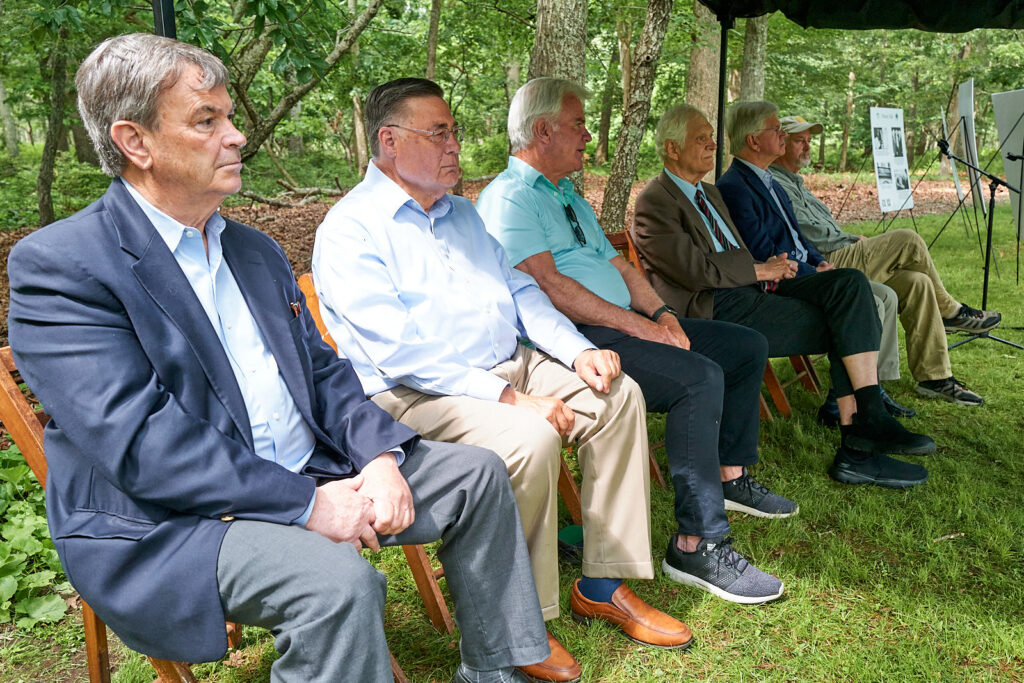
Photo by Wayne Cook
After a short break in speeches, and some live music from the returning Sunnyland Jazz Band, Society Board Member and environmentalist John Turner took center stage, to offer the crowd and attending representatives a deeper insight into the Society’s newest endeavor. The Best of The Rest will be one- year-old in August, and its progress and plan were told with a dedicated eloquence by Turner, keeping the energy of the event high as he spoke on the natural flora and fauna of the different properties. While many of us were already deeply involved with the initiative, Turner’s confident speech made it once again seem like a brave new campaign to preserve Long Island.
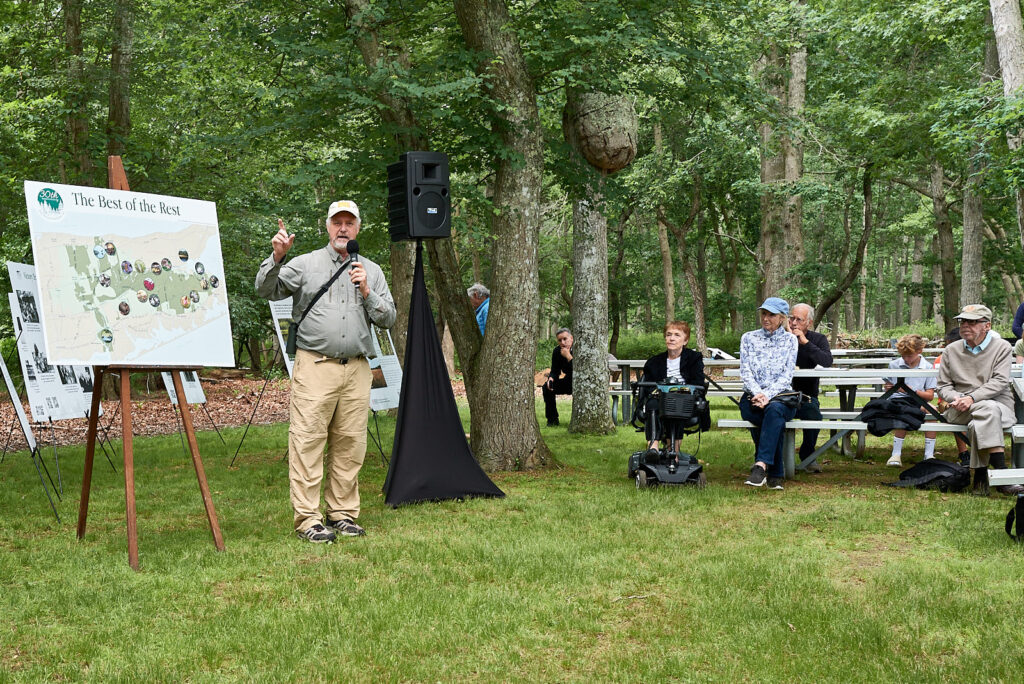
Photo by Wayne Cook
When Turner stepped away from the podium, another round of music followed, keeping the crowd in good spirits before moving into the last speaker of the day. It was about an hour and a half into the event when Society Board Member Nina Leonhardt took to the podium, to announce the results of the 2023 Middle School Kids Go To College Science Fair. The science fair, the culmination of a program sponsored by the National Grid Foundation since its inception, has slowly but surely become just as much a part of the Society’s identity as its preservation efforts, having run now for just over 10 years. The program has brought middle school students into a college environment, affording them the opportunity to visit Stony Brook University and hear a talk from SOMAS Professor Dr. Chris Gobler. Even in the deep years of the pandemic, students were assembled via Zoom, and given the chance to hear an in-depth explanation of Long Island’s water quality issues, before being asked to create projects of their own on the matter. Students would research, prepare, and present their projects independently, impressing Society staff more and more with each passing year.
This year offered us the unique opportunity to present the winners of the science fair their awards during the 30th Anniversary Celebration, instead of via zoom or at an indoor location. Leonhardt called students one by one to the podium, to be presented with their certificates of recognition. Dick Amper congratulated each student-scientist.
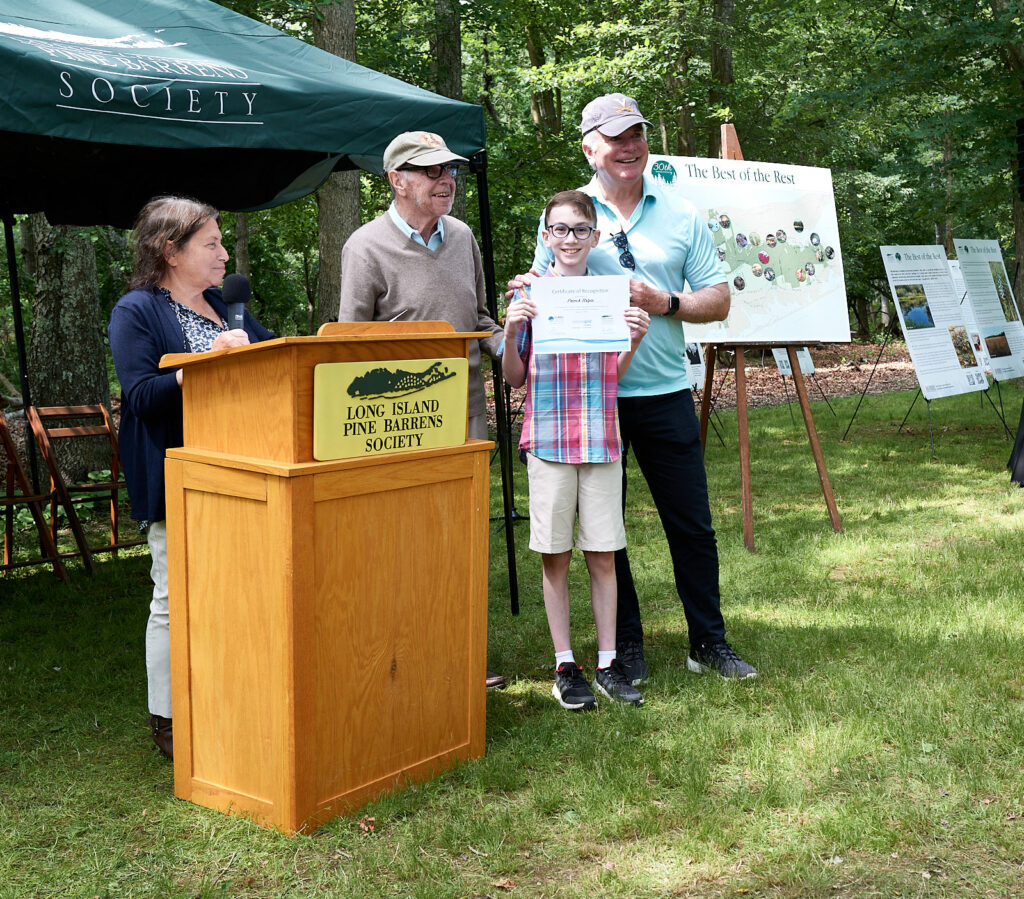
Award recipient student scientist Patrick Halpin standing with someone from the crowd, also named Patrick Halpin.
Photo by Wayne Cook
By the end of the short ceremony, moods were kept high by the band offering one final performance, before the speakers took a final bow, and dispersed for the more independent portion of the event. On the west side of the site, students had their award-winning projects on display for attendees to view and interact with. Right next to them was a collection of boards, detailing the timeline of events leading up to the Pine Barrens Protection Act’s passage, as well as plenty of materials about the Society itself.

Photo by Wayne Cook
And for those too giddy being in a park to stay in just one place, John Turner offered a special guided hike of the park, taking guests from the event site down to the Carman’s River. While it wasn’t a particularly long walk, it was jam-packed with observations and information. No plant went unchecked, and no single tweet from a bird went without identification. Though the walk itself would have only taken about five minutes to complete, the hike lasted closer to an hour as every possible detail was explained along the way.
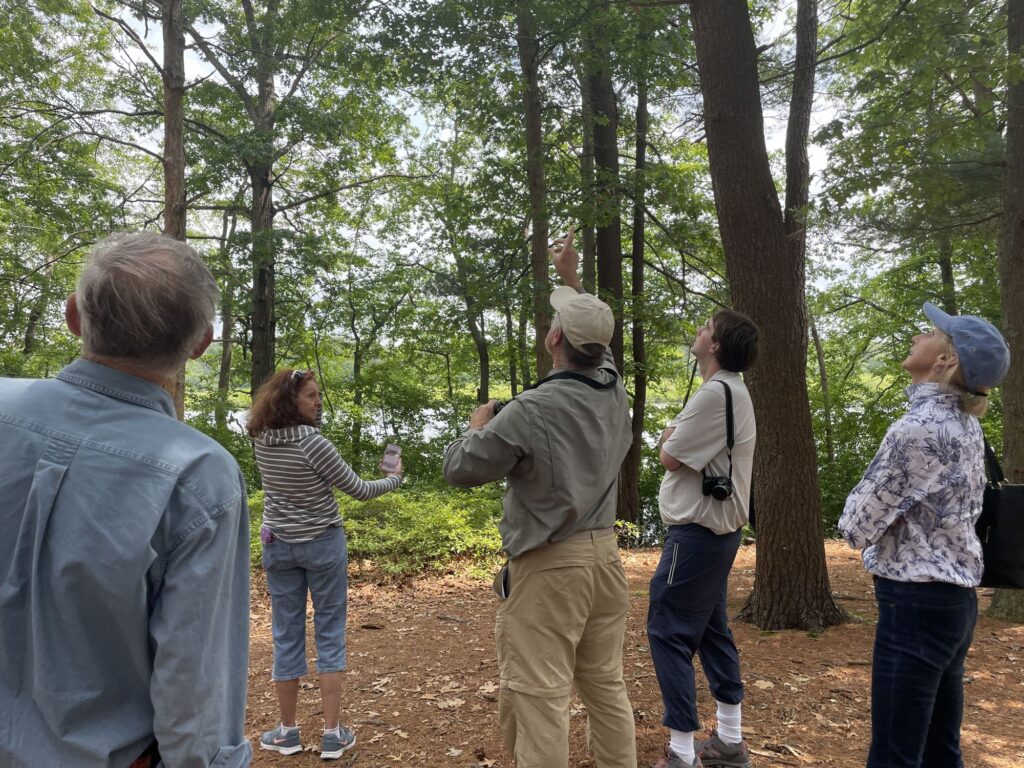
Photo by Dylan Eiden
And then, the event was over. Attendees stayed to chat for a bit, but by 12:30, you could barely tell there had ever been an event at the park. Then, as the last box was packed into the last car, the skies opened up, and the forecasted downpour finally came, lowering a literal curtain down over the Pine Barrens Protection Act’s 30th anniversary.
By Andrew Wong, Long Island Pine Barrens Society
Cover Photo by Wayne Cook
Posted on June 23, 2023 by Long Island Pine Barrens Society
Ingestible Invasives
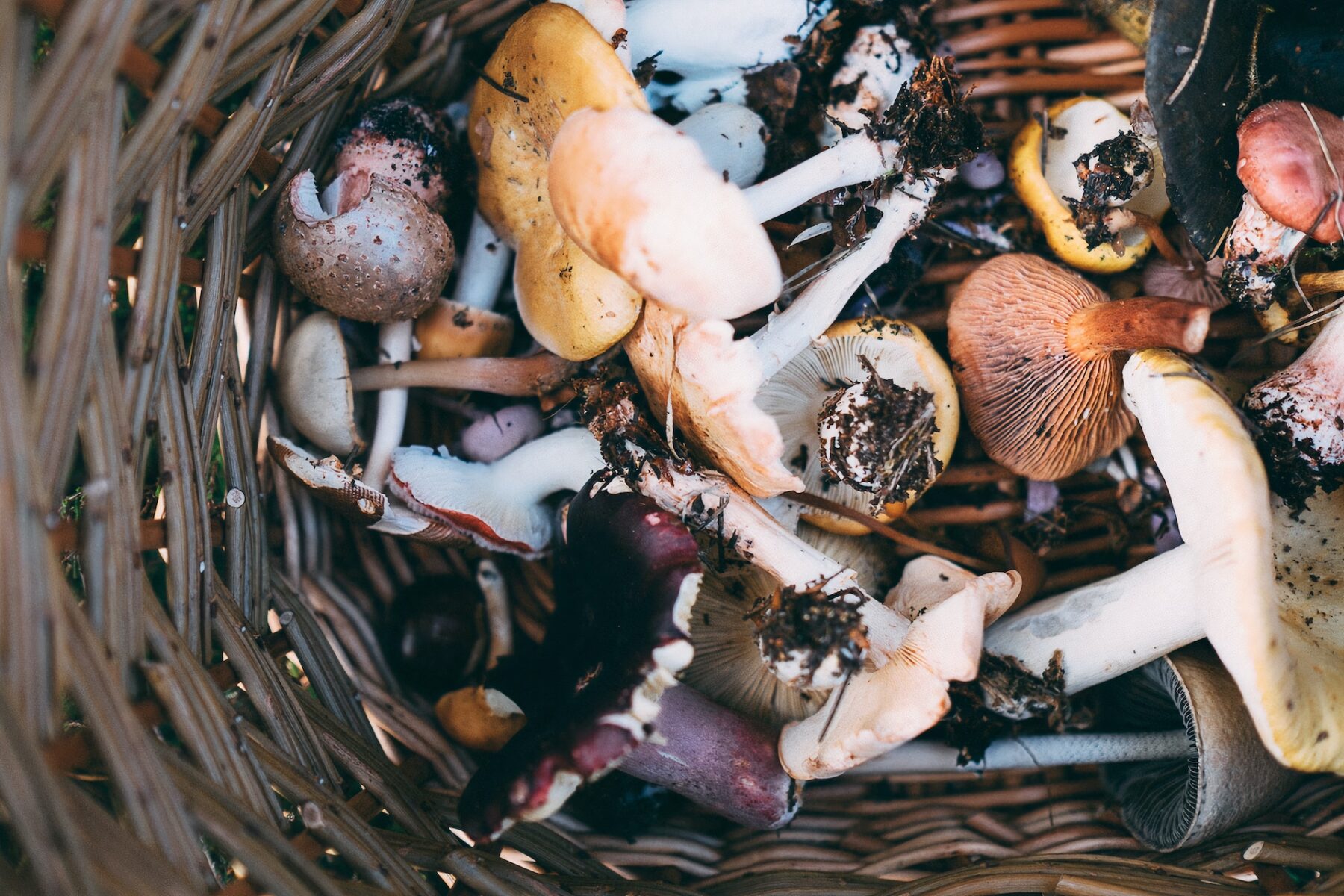
For those lucky enough to own a home, Spring is the season of lawn care. There are many fast spreading weeds and invasives to be on the lookout for, but none are quite as prolific as the dandelion and garlic mustard.
While dandelion is something of an icon in the world of weeds, garlic mustard is a bit more of an unsung pest, at least if you don’t know to look for it. Why not use your weeds to your culinary advantage, and try eating them?
Foraging was, for all intents and purposes, the first job any human ever held, and while it could somewhat share that title with hunting, there’s a whole lot more hoops you’ll have to jump through to go hunting on LI. Foraging, on the other hand, does not require permits, and in the case of weeds and Invasives, can usually be done right in your backyard. There’s a whole world of edible plants right here on the island, and community databases like fallingfruit.org can make it even easier to find them in your area. For the sake of simplicity though, we’ll just focus on the two big ones, dandelion and garlic mustard.
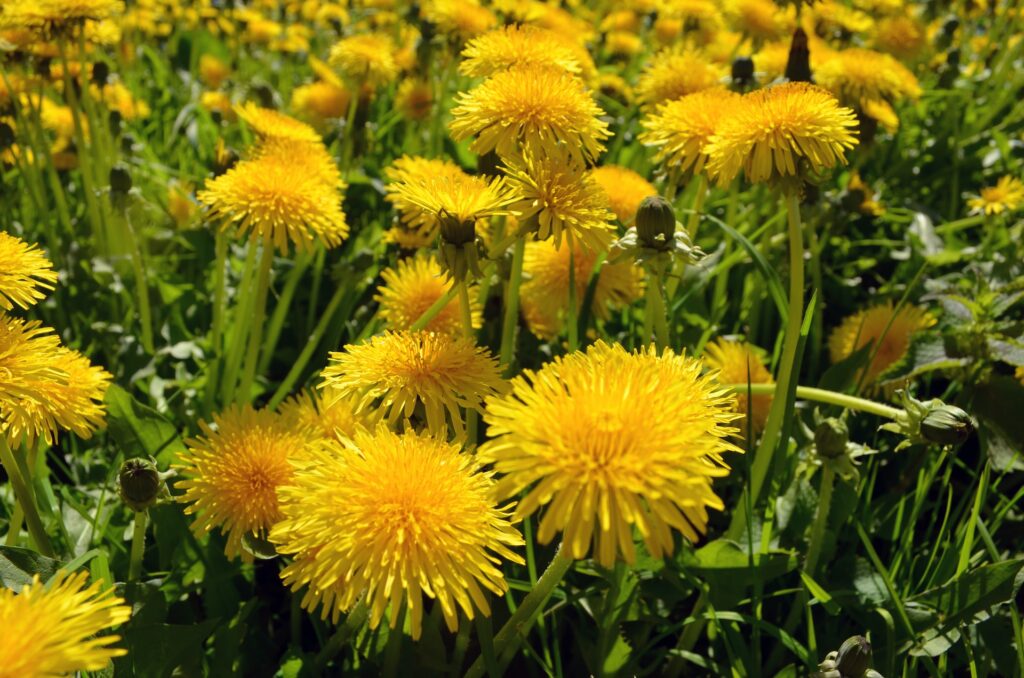
Photo By Viridi Green Via Unsplash
If you follow us on Facebook or Instagram, you may have seen a post from us a few weeks ago about eating dandelion. In that post we talked about using the greens for a fresh salad, or cooking them as a side dish. But did you know there’s even more you can make from the dandelion? If you find a young dandelion which hasn’t yet flowered, you can pull it out of the ground to find a much larger and denser root than you might otherwise. Dehydrating this root, either in a fancy machine or a low heat oven before crushing it in a spice blender will produce an earthy tea that can be enjoyed in place of any store bought bags. For the more mature plants that have already flowered, dandelion jelly makes quick work of those bright petals! This one is a bit more complicated, so we’ll just link our favorite recipe for the stuff instead. https://www.homestead-acres.com/how-to-make-dandelion-jelly/
As for the already tasty sounding garlic mustard, its uses are just about what you’d expect from the name! One thing to note about garlic mustard before going any further though, is that the plant, especially when young, contains a non-negligible level of cyanide. Although you would have to eat quite a lot of it to have negative effects, this can still be a concern for those who may consume cyanide through some other common foods. The best advice for dealing with this is to cook the harvested garlic mustard thoroughly to remove the cyanide (and also mellow the flavor) or to just follow the same rule as seafood when watching out for mercury, and consume in moderation.
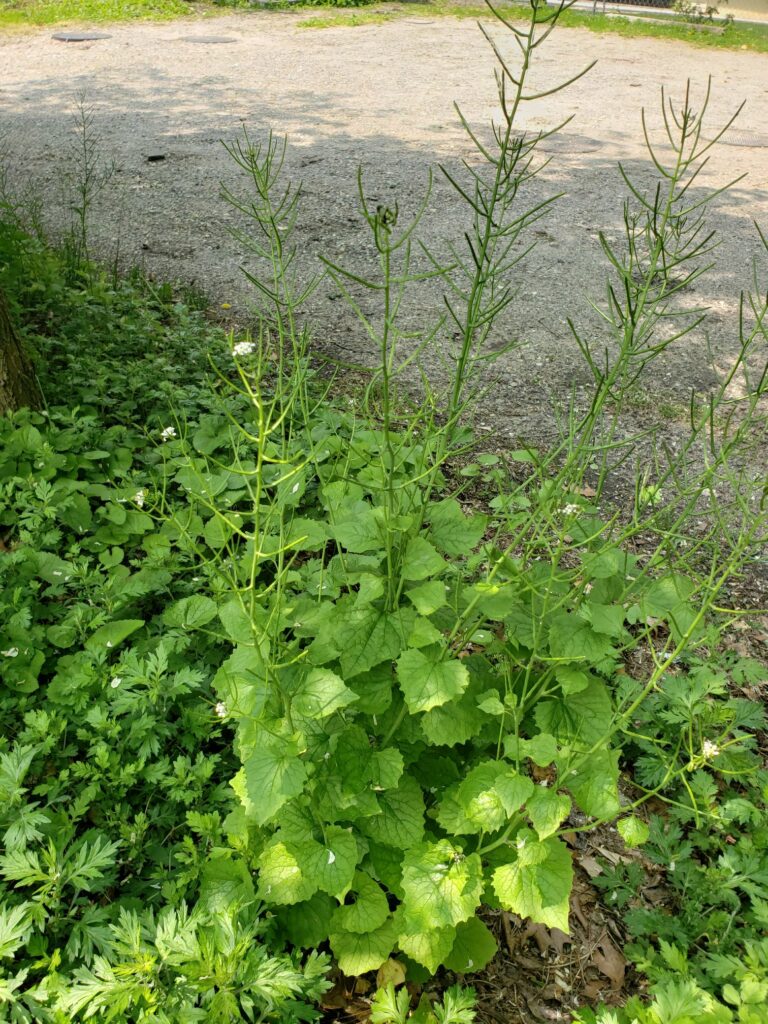
Some Garlic Mustard from right outside our office! Tastes like scallions…
When it comes to harvesting garlic mustard, you’ll want to take the tender upper stalks and flower from the plant. You should be able to easily snap the upper stalk right off, similar to asparagus, but if the stalk doesn’t easily break it may be too tough for consumption. Once harvested, the plant can be broken up into 3 core components: the stalk, leaves, and flower. The stalk can fill a role very similar to dandelion greens, and be eaten raw in a salad or cooked for a side dish. The flower and leaves will both have a much stronger, somewhat bitter flavor however, and should be used with caution. Small amounts of each can be added into anything where you might use normal garlic for a heavy hit of flavor, with dishes like pesto or hummus being the most common.
Hopefully, this has given you a bit of inspiration to finally deal with that patch of weeds slowly spreading along the edge of your garden, and if not, hopefully it’s at least reminded you to eat your greens today!
By Andrew Wong, Long Island Pine Barrens Society
Cover Photo by Annie Spratt Via Unsplash
Posted on May 22, 2023 by Long Island Pine Barrens Society
Recommendations From The Board of Directors

We’re a month into spring now, how is everybody enjoying (or not enjoying) the warmer weather? While it may still vary fairly wildly, the warmer temperatures are a great incentive for most people to get out and go for a hike! If you’d prefer to just rest in a nice park or along a pretty trail though, we have you covered with the perfect activity for doing so, reading! For this month’s blog, we asked a few members of our Board and our executive director for their best environmentally- themed book recommendations and compiled them here.
Of course, if you have any recommendations yourself, do let us know as well! It’s hard to go particularly wrong with a book recommendation.
To start, Board member Elina Alayeva had two recommendations to share with us that were so detailed that we’d feel bad offering you anything but her direct quotes!

The Overstory, by Richard Powers.
“It’s an incredibly ambitious novel and a deeply moving exploration of the interconnectedness of all living things, particularly trees. It tells the story of nine characters whose lives are all profoundly affected by trees, whether they know it or not. The writing is beautiful and lyrical, and the book is both informative and emotionally resonant. Reading it outside in the spring will only deepen an appreciation for the natural world and the complex web of life that sustains us all.”
An American Sunrise, by Joy Harjo.
“A poetry collection by Joy Harjo. Harjo, a member of the Muscogee Creek Nation and the first Indigenous Poet Laureate of the United States, writes emotionally resonant poetry often touching on her heritage. This collection explores themes of history, memory, and resilience, as she reflects on her own family history and the history of Indigenous people in America. It’s a lovely celebration of the natural world and a reminder about the power of storytelling.”
Next up, was a recommendation from Board member Suzanne Ruggles.
“Profound interactions between people and nature … perfectly written.. my favorite page turner.”

Suzanne recommends Prodigal Summer, by Barbara Kingsolver, an anthology of stories about people who share the same land, and how that land affects and changes them, and their relationships. The book connects themes of the human spirit and of nature, to create a story that stands tall even among its contemporaries.
Our third Board member to offer a recommendation this month is Nina Leonhardt. Nina recommends Beyond Words: What Animals Think and Feel, by Carl Safina.

“This wonderful volume explores animal intelligence, communications and feelings from the perspective of the animal, rather than trying to define how animals are similar to us. Each species should be valued and appreciated for its traits and understood in those terms.”
Next, Board member John Turner offered an in-depth review of An Immense World, by Edward Yong.

“One of the best books I’ve ever read. It highlights the countless sensory adaptations possessed by animals such as echolocation in bats, bloodhounds’ sense of smell, elephants’ use of infrasound, and birds and insects seeing ultraviolet light. The book makes clear we live in a remarkable world filled with wonder……I would HIGHLY recommend the book. “
Mr. Turner also wrote an even lengthier review of the book to be featured in TBR Media’s “Nature Matters” section later this month.
Finally, no list of book recommendations from the Society would be complete without the first publication from our own executive director, “Saving Long Island: The David and Goliath Battle to Preserve the Pine Barrens”. Written by Richard Amper, this book describes the long road from the founding of the LIPBS to the passage of the Pine Barrens Protection Act. Called an “Essential reading for Long Islanders” by its author, this book is a must not just for conservationists, but for anybody looking to learn more about what it takes to protect even the smallest park.
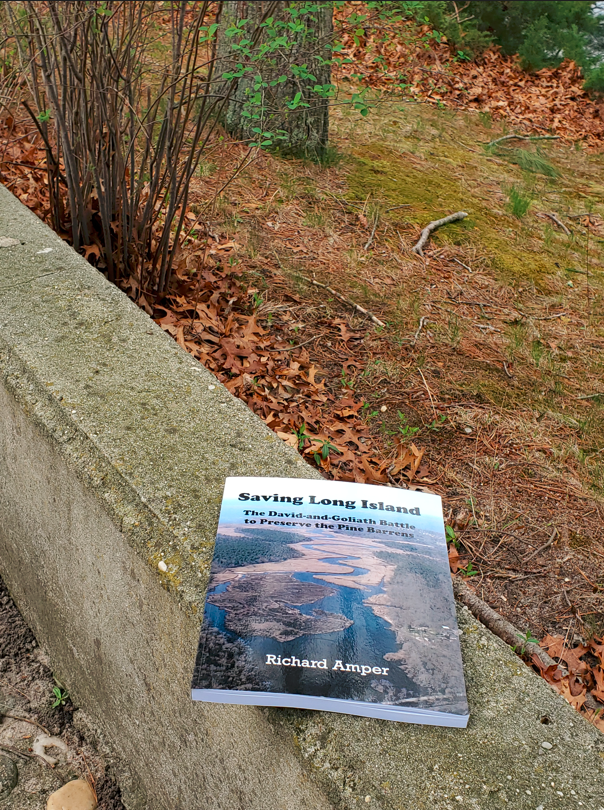
We hope you’ll take some time this spring to get out and get reading while the weather is still nice, though keep an eye out for those April showers!
By Andrew Wong, Long Island Pine Barrens Society
Cover Photo by Ed Robertson on Unsplash
Posted on April 20, 2023 by Long Island Pine Barrens Society
Spring Activities Both Indoors and Out!
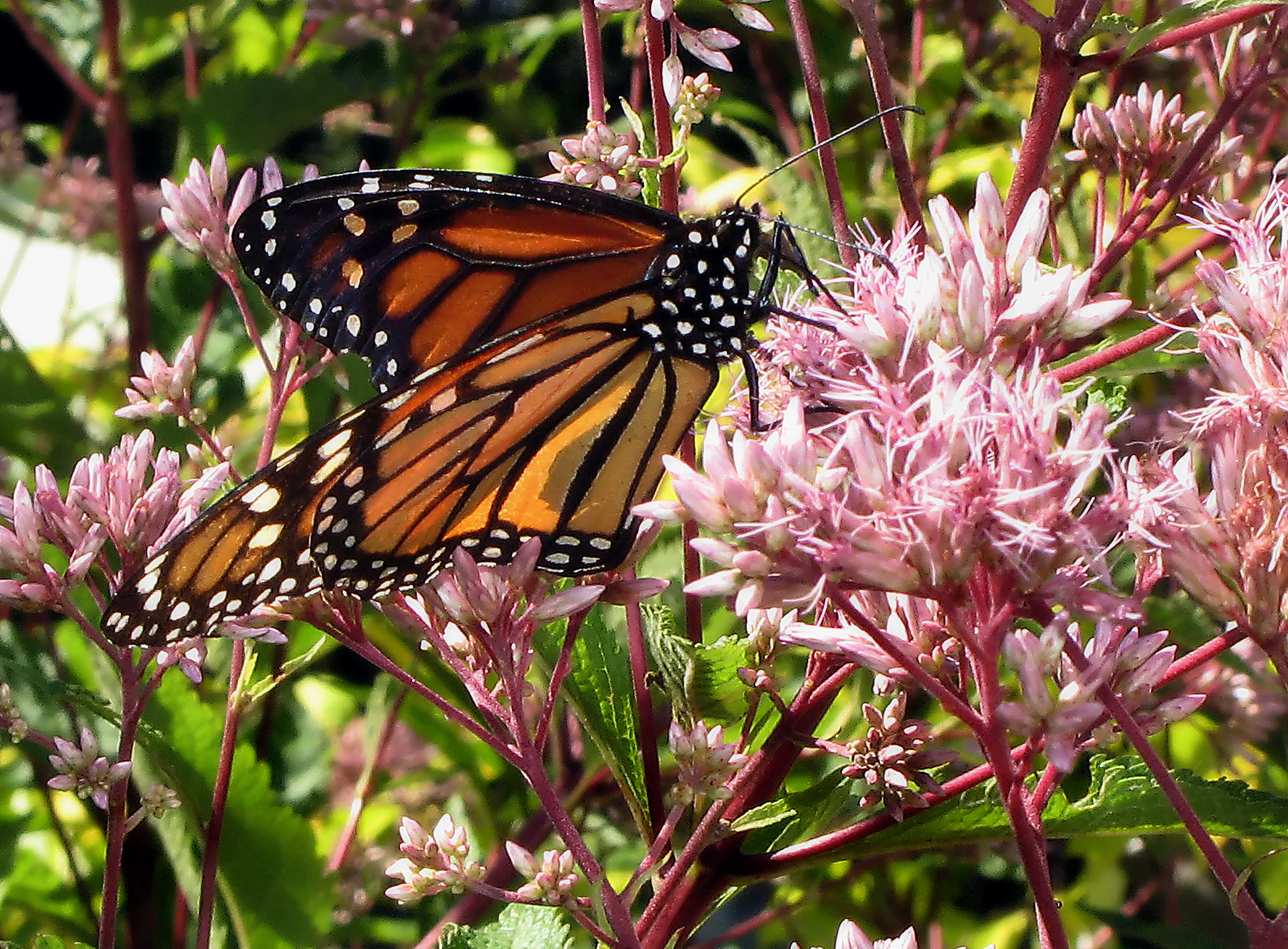
Spring is finally here! Though the temperature this morning may not feel like it, this is a long-awaited reprieve from the frigid months that preceded it (even if we did just get snow last week). For some, though, it’s a sad moment to put away their layered clothes and go back to their warm weather wardrobe. Whatever spring may bring for you personally, there’s no shortage of activities both indoors and outdoors to enjoy during the season! So, follow along with this month’s blog, as we go over some of our favorite springtime activities!
Go for a Hike!
Hang on, hang on! Put those pitchforks away! I’m not here to offer the same few lines about going for a hike that we usually do, that’s being reserved for our 12 for 12 campaign. Instead, I want to talk about some of the specific things to be on the lookout for during this season! The first thing you’ll notice if you’re coming off a few months of winter hiking, is the way that color is slowly seeping back into the dense trees along your favorite trails. It’s already starting in a few different trees, but the next few weeks especially will be filling the tops of those trails back up with a dense brush. Because of that, you may actually find your hikes to be a bit cooler than they were in the winter, since you’ll be in the shade, rather than in direct exposure to the sunlight.
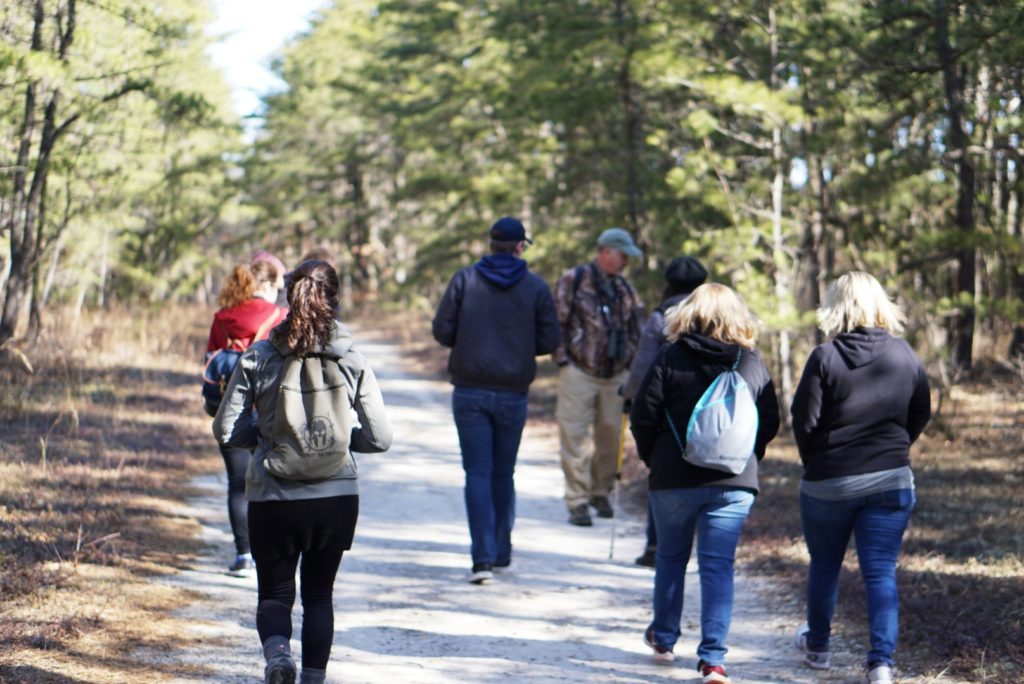
Group Hike at Cranberry Bog Preserve
Something else to be on the lookout for this season are, unfortunately, ticks. Spring is the season when the previously dormant ticks will begin breeding, and increasing in population again, making it more important than ever to make sure you’re prepared. We’ve got plenty of information right here on the LIPBS website on how to protect yourself, but we’ll summarize here: Cover up as much as you’re comfortable with, check yourself in the mirror when you’re done, and be careful, but not paranoid!
Write Some Haiku
For those not familiar with it, Haiku is a style of Japanese poetry that emphasizes structure, and seasonal elements. The falling leaves of autumn, the snowfall of winter, spring showers, or the sweltering heat of summer all apply, as well as anything else that’s only prominent in a single season. This particular style makes it perfect for an indoor appreciation of spring, for those of us not too keen on taking a hike. As it stands though, the seasonal elements of haiku tend to be overshadowed in western discussion by its particular format, that being of 575, 5 syllables, then 7, then 5 again, for a total of 3 lines. The difficulty with this is, of course, that English and indeed any Latin language lack the syllable structure that allowed for this style to emerge in Japan. In Japanese you would count both letters in the word “is” as a syllable, but no such thing is done in English. This can make it especially hard to put together an “authentic” haiku if you don’t have a firm grasp on what constitutes a syllable in the English language. That said, you shouldn’t let something like this stop you from enjoying this seasonal style of poem. It certainly won’t get you any kind words on a haiku forum, but if you want an easier format to follow, try basing 575 on groups of 3 letters and smaller words instead.
So this line
Followed by this one
Makes a haiku
It’s not technically a haiku, but letting technicalities stop you from expressing some appreciation for the season is more of a disservice to the poem than messing with the syllables a bit.
Gardening (again)!
Our whole blog last month was all about gardening, so I won’t be going into it here, but if you’ve never tried gardening before, the best time to start is always whenever you’re reading this! At almost every time of the year there’s a plant that’d be perfect to start seeding or growing, and that comes down to consulting your area’s growing guide. Even if you don’t want to dive in headfirst, consider buying a potted plant at your local hardware store, and see how long it takes for it to outgrow the pot it came in! You might be surprised just how well you do on your first try!

Photo by Markus Spiske on Unsplash
Take up Cycling!
As it gets warmer out and the days become clearer, it’ll be easier and easier to cycle around your neighborhood, either for leisure or transport! Long Island overall isn’t exactly the best area for long distance roadside cycling, but more and more towns and villages are introducing bike lanes along the sides of the road, making it safer than ever to replace some of your drives with rides!

Always wear a helmet when cycling!
Photo by Jonny Kennaugh on Unsplash
If you don’t already have a bicycle, you can find relatively simple ones at lower prices in big department stores, but what you won’t want to skimp on is the helmet. If you go low on your bike price, you may find that most recommended helmets are almost the same price as your bike, but this is an important area to choose quality over price. Having a flimsy helmet won’t much if you take a nasty spill and knock your head on the road, so don’t skimp on this piece of equipment. A bike lock is the only other thing you’ll need if you plan to use your bike for transport and not just leisure. There’s a whole assortment of add-ons you can get for your bike to make it a real force to be reckoned with!
Hopefully, this spring, you’ll take some of our suggestions here, and find yourself something fun to do, be it indoors or out!
By Andrew Wong, Long Island Pine Barrens Society
Cover Photo by Sandy Richard
Posted on March 20, 2023 by Long Island Pine Barrens Society
Getting Started with Gardening
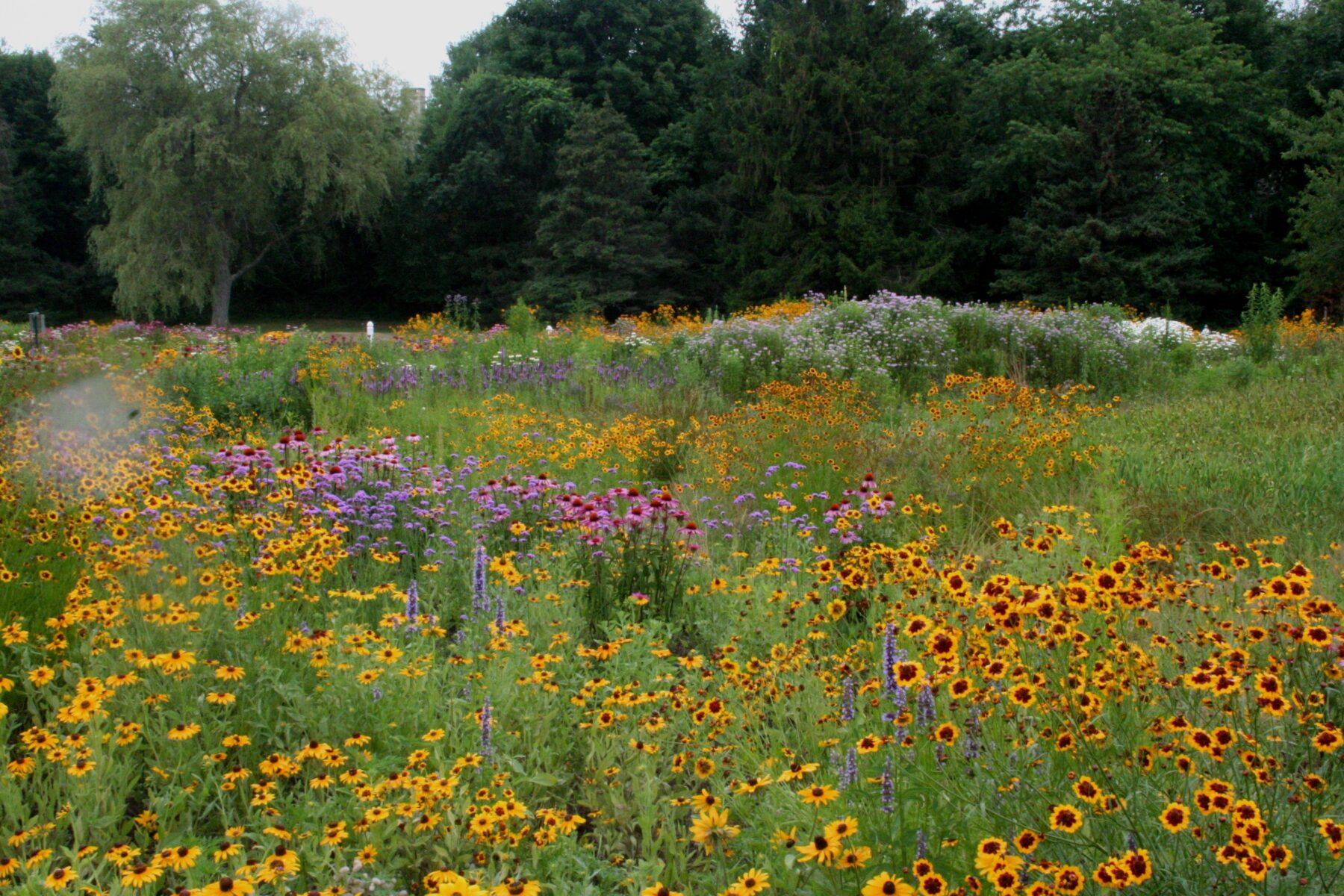
February is nearly gone, and while the cold weather may still be keeping us wrapped up, it’s a good time to start thinking about your summer or spring gardens! Never had a garden? Don’t have the green thumb for it? Living in an apartment smaller than most closets? Don’t worry! We’re here this month to make gardening fun and easy for you as we are nearing the start of Spring!
First Steps
When it comes to actually starting a garden, you tend to have a lot of options for exactly “where” to start. Getting a packet of seeds and kicking off your garden from scratch is perhaps the most obvious way to go, but if you’re a first timer, you may want to consider starting with a seedling instead.
These plants have already sprouted, and just need to be placed in a pot or in the ground with soil. If you decide to take this route, then you’ll likely not be in short supply of seedlings to choose from, since just about any spring farmers market is bound to have somebody selling them by the truckload. If you’re looking to go more corporate than that, most chain hardware stores will also have a section of either seedlings, or fully grown plants for you to drop out back! Of course, if you take this route then February isn’t really going to be when you’re starting your garden, it’ll probably be late March.

Photo by Markus Spiske on Unsplash
If you do want to start from the bottom though, now’s a good time to get certain seeds going indoors, to get a head start on growth. There are many great guides by people more knowledgeable than us about the exact temperatures and water levels you should be keeping your planters at, so we’ll hold off on the specifics here.
When To Move Outside?
At a certain point your seedlings will outgrow their indoor habitat and need to be moved to individual planters or a garden plot. If your plants aren’t visibly outgrowing their pods, you’ll still want to do this around the end of March or by following a handy chart like this one to know exactly when your plants should be moved.
If you are a first-time gardener, we recommend buying a set of planting pots or buckets for your seedlings, since you can know exactly what kind of soil you’re putting in with your plants and can monitor them more efficiently. A full set of light brown clay pots may be tempting for their aesthetic, but if you’d prefer function and affordability, then large paint or “homer” buckets are the perfect home for your new garden residents. These buckets can even be easily turned into self-irrigated planters, or SIPs!

The Namesake of the “Homer” bucket itself, taken straight from their website
Similar to the seeding process, there’s complexity here that we’ll leave to the experts, but you’ll want to fill your planters most of the way with soil before planting your seedlings inside. From there you’ll have to adjust the planter’s location and watering schedule based on how much light and moisture the seedling needs, but once you’ve got a routine down you’ll be well on your way to a delicious summer harvest!
A Warning
Especially now when food prices are quickly rising, it can be extremely tempting to start a home garden to save on produce come summer. But what you should know before taking the plunge is that gardening is very much an investment in time and money. Getting the necessary supplies you need to get started can easily present you with a bill in the triple digits. And you have to pay attention to your seedlings. It’s also important to remember that successful guides and videos of people with bountiful harvests are rarely, if ever, people’s first time doing this. Gardening is a skill which takes years to learn, and a lifetime to master, so don’t be discouraged if your first few planters don’t bring you a supermarket-sized harvest. Being able to garden is on its own a joy and a luxury, and unless you want to drive yourself insane before summer, don’t worry too much at the start!
By Andrew Wong, Long Island Pine Barrens Society
Posted on February 23, 2023 by Long Island Pine Barrens Society
Introducing the LIPBS 12 for 12!

Happy New Year! The year 2022 has come and gone, and as fast or as slow as it may have felt for some, it was, for the Long Island Pine Barrens Society, an extremely busy year! We ran the third consecutive year of our Robin Amper Environmental Scholarship competition and continued our extremely successful Middle School Kids Go To College Program! We also had a rousing success with our 45th annual Gala, and launched our newest initiative, “The Best of The Rest”!
We’ve got even bigger plans for 2023. Here’s our first event, one in which we hope you will join us. When we post or reference the ideal spots to hike, we tend to reference our favorite preserves from our hiking recreation guide. But this year, we want to try something new. We would like to hear what favorite parks our fantastic supporters visit. So, to celebrate the new year, we’re kicking off the 12 for 12 guide!

How it Works
As the name implies, 12 for 12 will be a monthly “event” on our social media pages. We would like to know where you hike every month of the year! On Facebook and Instagram, we’ll tell you where we hiked, and in exchange, tell us about your favorite spots from that month! Bonus points for Pine Barrens trails of course, but even if you just went for a walk on your local greenway, let us know.
Each month we’ll share which trails we hiked along, as well as one fun fact about them! The posts will go up on the third Friday of every month, barring special occasions, so you’ll have plenty of time to get to your favorite trails! Then, come December, we’ll select a mix of the most popular trails among our supporters’ submissions, as well as some of our favorites, to create a new hiking guide for 2024, composed entirely of your and our hiking experiences!
As an extra incentive, everyone who completes the 12 for 12 by posting about their hiked trails every month in response to our post, will receive a special certificate mailed to them! They’ll also get a copy of the newly published 12 for 12 guide, so their 2024 can be just as full of enjoyable hikes as 2023 was!
But without further ado, let’s kick off the 12 for 12! In a few days our Facebook and Instagram accounts will update with this month’s hike recommendation from the staff, but readers of the Bridge to the Barrens will get it early!
The Setauket Greenway
When we said we’d be giving bonus points to those mentioning Pine Barrens Trails, we may have been including ourselves in that listing! Our first trail recommendation, the Setauket Greenway, comes from our program coordinator.
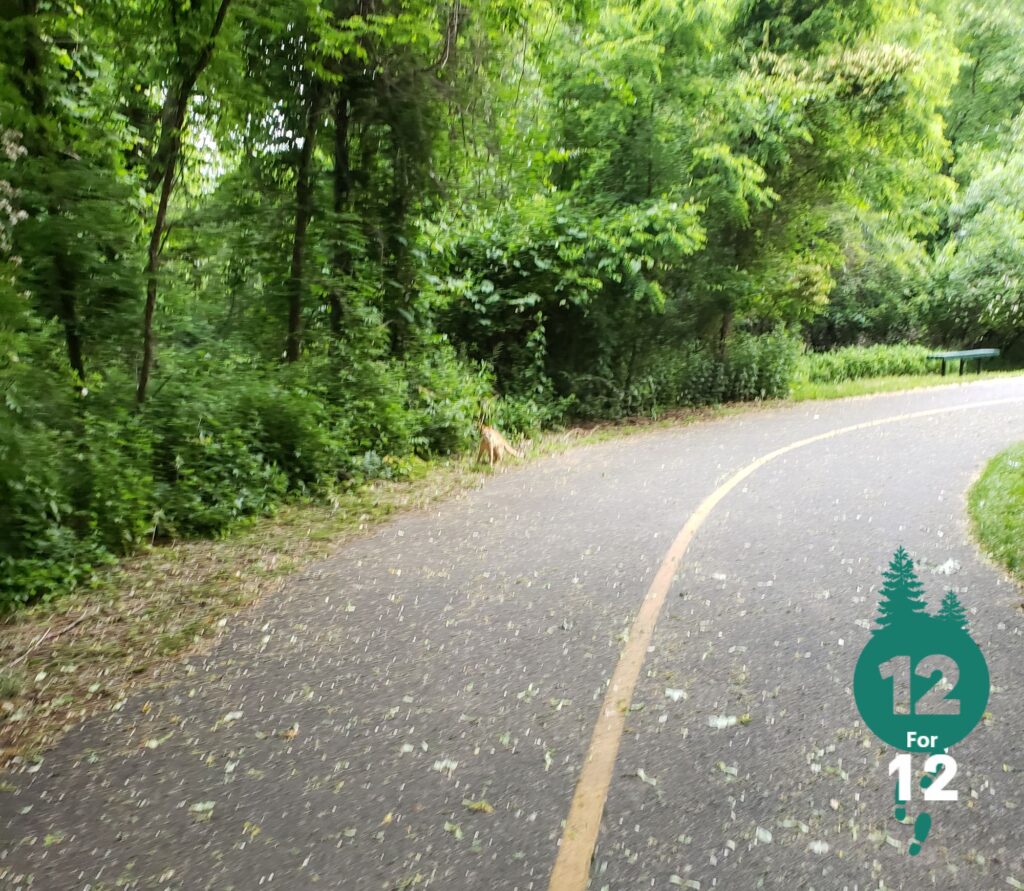
The path along the Setauket Greenway, just off of Possum Ln.
The trail is about 3.5 miles long and runs from Port Jefferson Station’s shopping plaza to the East Setauket post office. The trail itself is paved with black asphalt from start to finish, with some guard rails being in place at certain stretches, making it very much so an urbanite’s trail. Its main stretch cuts through the heart of Setauket’s open space, making it an ideal trail for residents looking to take a casual walk, either in the morning or after work.
Notable fauna include Long Island’s premier white-tailed deer, as well as your standard backyard critter fare, including the eastern gray squirrel, and various species of local birds. Occasionally visible in addition to those is the much larger Cooper’s hawk, which may roost in trees or among other flora.
Speaking of flora, as you move along the trail from Port Jeff Station to East Setauket, you’ll be treated to a gradual shift in greenery, with the dense brush in the heart of Setauket more resembling a viny bog in contrast to the more recognizably wooded Port Jeff side.
Barring a few steep hills, the Setauket Greenway Trail is an extremely casual trail, ideal for those who either haven’t hiked before, or who may be local and are looking for something quick and easy. Scattered benches also provide plenty of rest spots, and the few roads it cuts across feature light up crosswalks and signs to alert passing cars of hikers.
If you live in the area and haven’t taken a walk along the trail, either because you weren’t interested or didn’t have the time, we absolutely recommend taking your next casual walk along its easy, if sometimes sloped paths.
Have you hiked anywhere this month? Let us know on our social media pages, or send us an email at info@pinebarrens.org to take part in our 12 for 12!
Posted on January 20, 2023 by Long Island Pine Barrens Society
How To Enjoy Winter in The Pine Barrens
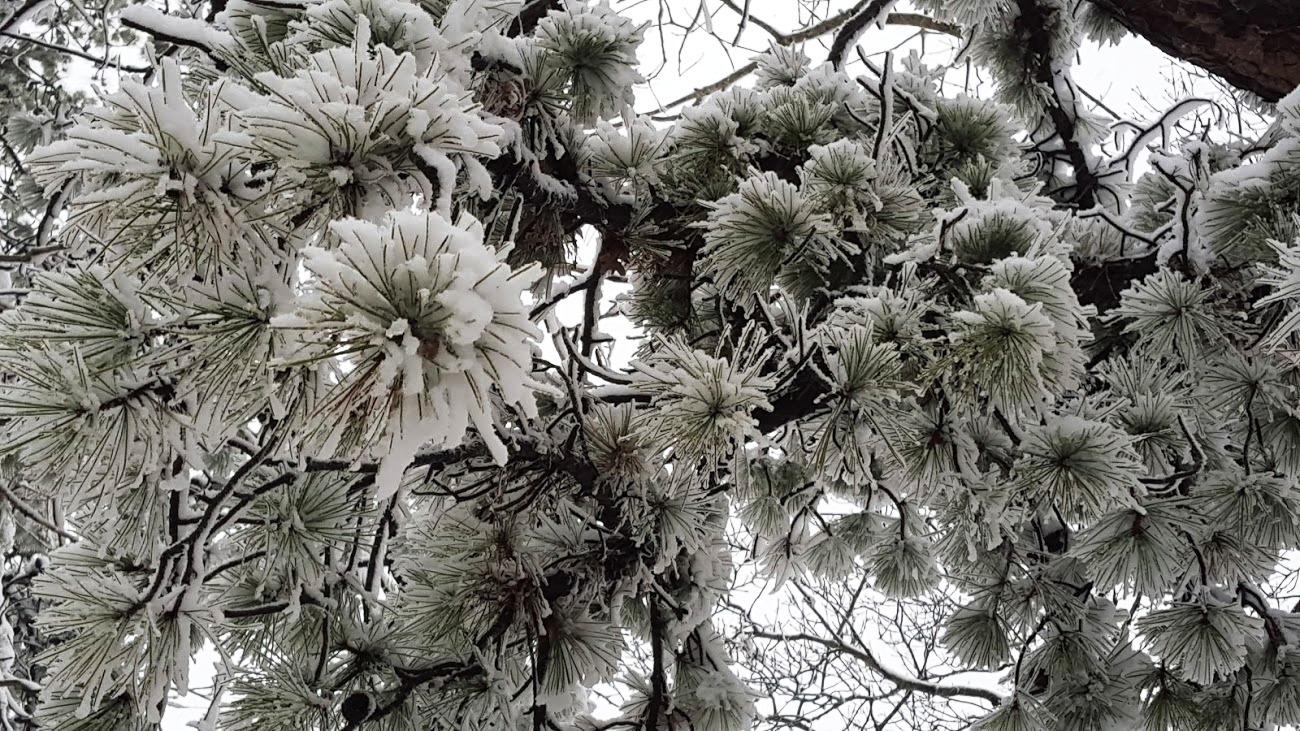
With cold weather upon us, and only more of it to come, a question of how to best enjoy your hikes can arise. Some people, for one reason or another, can’t stand the sight of dead leafless trees, and would prefer to avoid them entirely. On the other hand, some may love the new sights that come from the loss of that dense foliage, allowing you to more clearly see birds in the trees or the sun in the sky. Whatever your preference is for the winter months, we at the Long Island Pine Barrens Society hope to show you all the ways to enjoy the Winter!
The Perfect Time for Birdwatching
While it might be sad to see trees lose their gorgeous color in the winter, there’s no better time to get some birdwatching in! The lack of leaves clears up the tops of the trees and allows for far easier spotting of some of Long Island’s local species!
In our Winter Recreation guide we recommend the Indian Island Country Park as an ideal spot for Winter birdwatching. The local beaches give an ideal view of any birds that might nest in the sand, and can also offer a fine view of the Peconic, however those who have followed us since August may remember a different spot for birdwatching we recommended. Can you remember what it was? Have a look at the image below while you think.
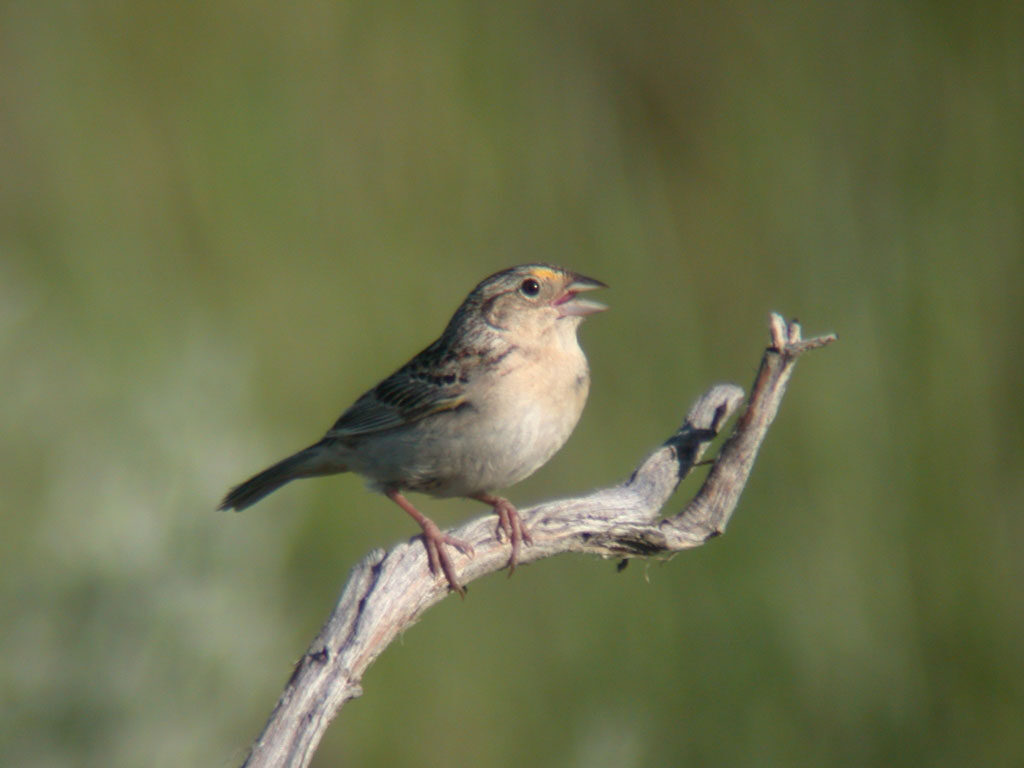
Remembered? Don’t worry, we’ll be giving you the answer regardless!
It’s the EPCAL Multi-Trail! Home to the previously picture Grasshopper Sparrow, and to one of the many properties we’re seeking to preserve with The Best of The Rest! As previously mentioned, the thinning out of the trees will make it even easier to spot birds high up in their branches, making it the perfect chance to try and spot one of these little tweeters.
Enjoy a Walk Along the Beach
While a trip to the beach may not seem like an ideal winter activity, it’s actually a perfect time to do so! The cooler weather will keep the sand close to the water firmer, and easier to walk along, and as mentioned in the last section, there are plenty of chances for birdwatching! The “notorious” Piping Plover can be spotted along many of the beaches across the island, along with a variety of other shorebirds to be spotted, making for some perfect photo opportunities.
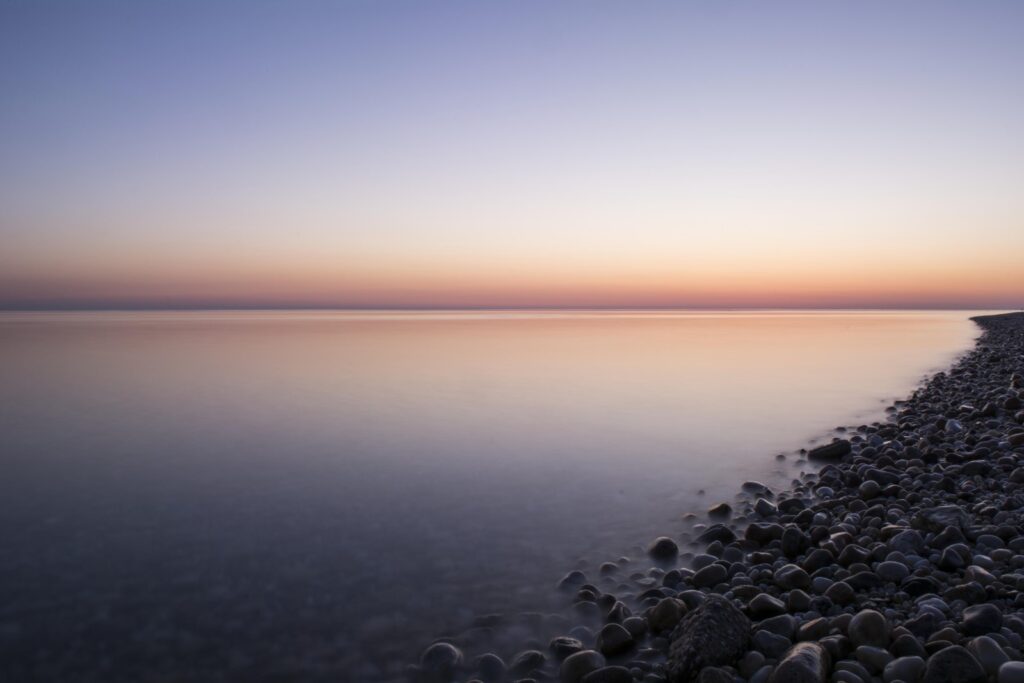
Port Jefferson Shore – Photo Credit: Josh Ardle
And speaking of photo opportunities, the Winter months create a period of far clearer air than the rest of the year. As a result, sunsets along the beach will be even more vibrant than usual, making these cold times the perfect chance to practice your photography.
Take a Hike
Just because you’ll need a few extra layers doesn’t mean you can’t still go for a hike! Even without their vibrant leaves, Long Island flora, are uniquely beautiful come wintertime. If you decide to brave the trails, check out the bark patterns on any trees you pass, and see if you can still recognize them without their dense leaves!
A special benefit of the barren pines is the way sunlight can so easily pass through them, illuminating trails in a way not possible any other time of the year! Combine this with a recent snowfall, and your hike will be accompanied by an otherworldly radiance coming from sunlight reflected off the snow. This naturally applies to just about any trail in the pine barrens, but Prosser Pines Nature Preserve is a location we especially recommend for the winter months.
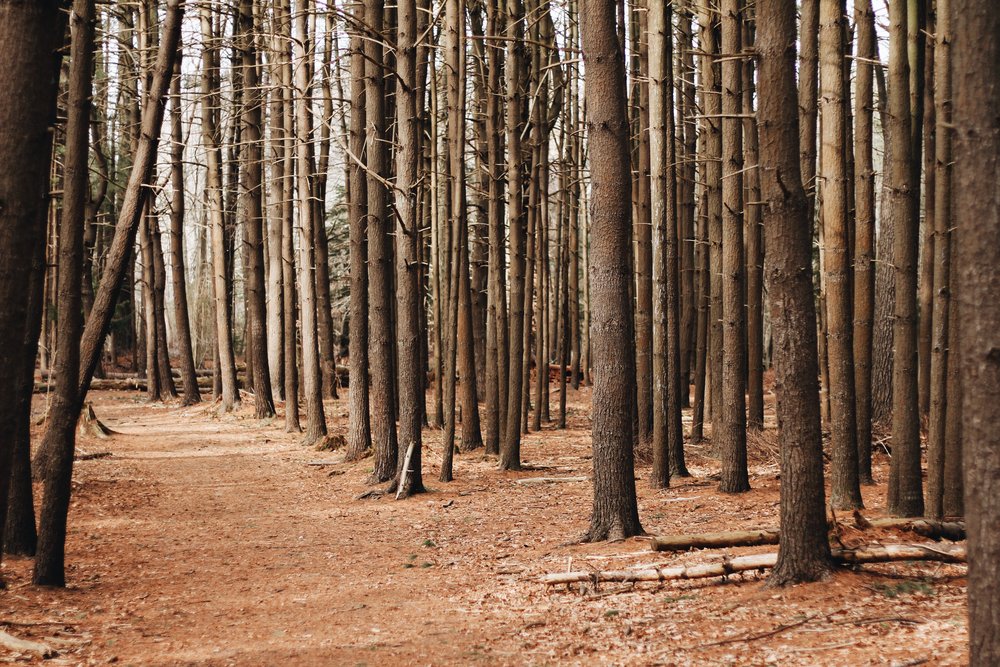
The Prosser Pines Nature Preserve
And for those of you who are Society members, check out our Thicket column in our most recent newsletter, The Pine Barrens Today, where winter hiking is featured.
Skip the Hike and Stay Home
Alright, so, not exactly a way to experience the Pine Barrens in the winter, but if the concept of a winter hike turns you off that much, you can always opt to huddle down for the season. If you find yourself still wanting a trip to the barrens though, consider checking out our TV show, available through our YouTube, or on channel 20 for Suffolk County residents. It may not be a perfect substitute for the outdoors, but with it you can learn a little more about the barrens, and get to see some gorgeous scenery, captured in gorgeous 360 resolution.
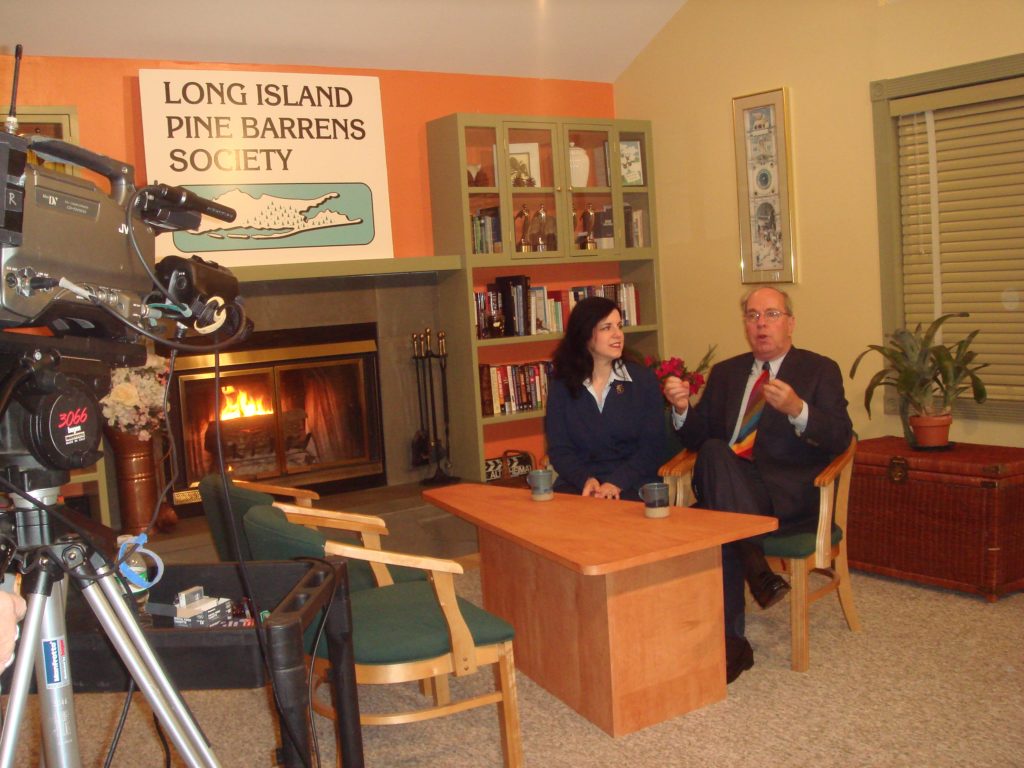
Co-Hosts Richard Amper and Kathleen Nasta on the set of The LIPBS TV Program
Alright, maybe that last point wasn’t completely serious, but there are still plenty of ways to enjoy the barrens in winter that I didn’t outline here. Even more of those can be found in our Winter Recreation Guide, or by reaching out and just asking for a recommendation!
We at the Long Island Pine Barrens Society hope you’ve had a good year and wish you luck and fortune going into 2023!
By Andrew Wong, Long Island Pine Barrens Society
Cover Photo: Katie Muether Brown
Posted on December 20, 2022 by Long Island Pine Barrens Society
3 Tips For a More Sustainable Thanksgiving
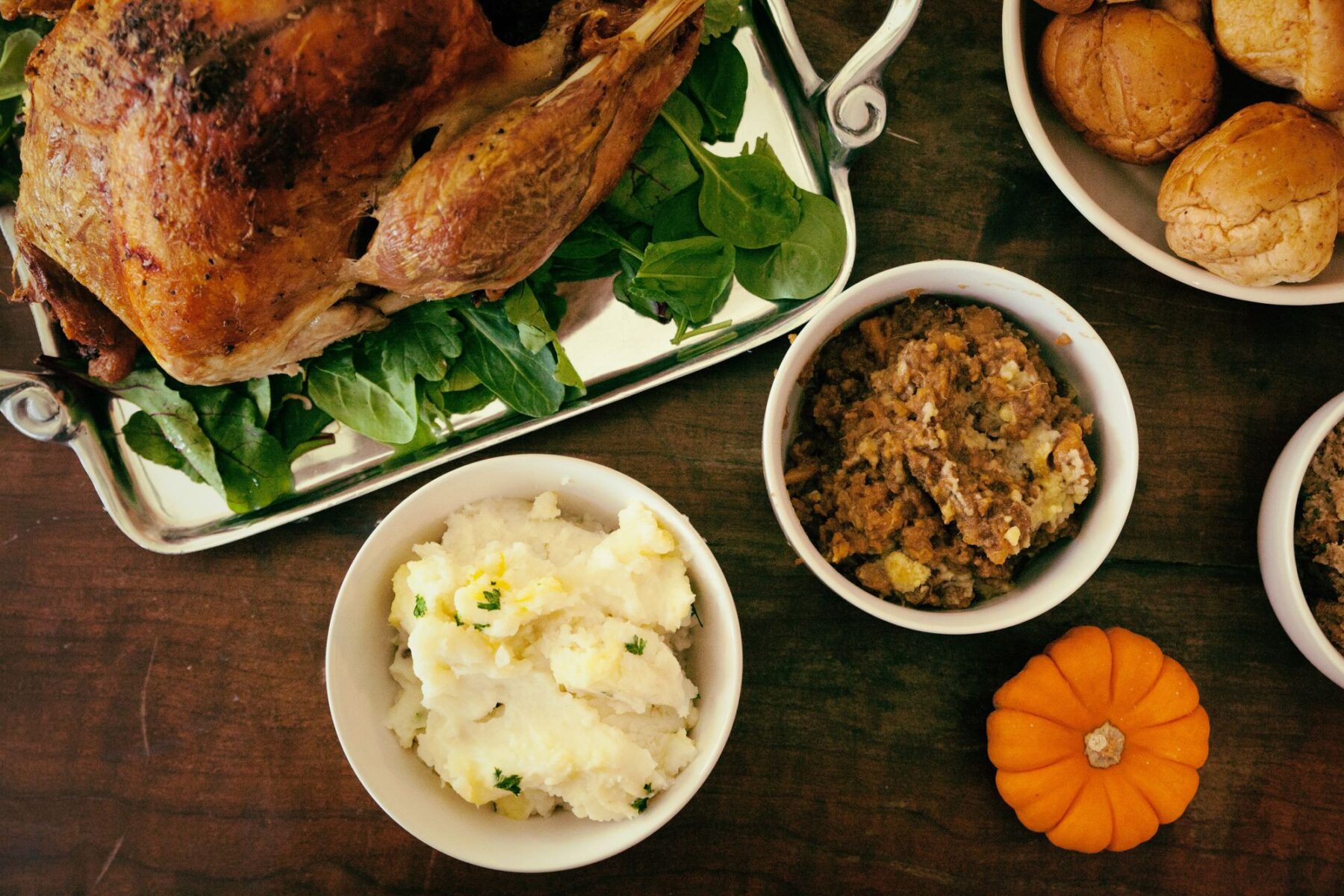
It’s that time of the year when we need to prepare a three-course meal, usually complete with a selection of appetizers, sides, and a main course involved enough to take up half of the day. Whatever form your Thanksgiving takes, there are many ways we can make the holiday a bit more sustainable, for us and our planet. So, join the LIPBS this month as we walk you through the steps to make your Thanksgiving just a bit greener, without the need for another green bean casserole.
Reducing Food Waste
Surprise! The biggest and most significant thing you can do for a more sustainable Thanksgiving is to reduce the food wasted at the end of the night. Most of us probably already do this by sending our guests home with leftovers or enjoying a sandwich made from leftovers the day after. There are some additional steps you can take in the preparation and aftermath to reduce the amount of food going into the trash.
Composting is an involved hobby, but one that will quickly pay for itself if you have a garden you regularly fertilize. Your compost location makes a good final destination for any unused vegetable ends or bits from your prep. We don’t quite have room to fully explain composting here, but our friends at the DEC have their own guide made specifically for New Yorkers, all about how to compost for beginners.
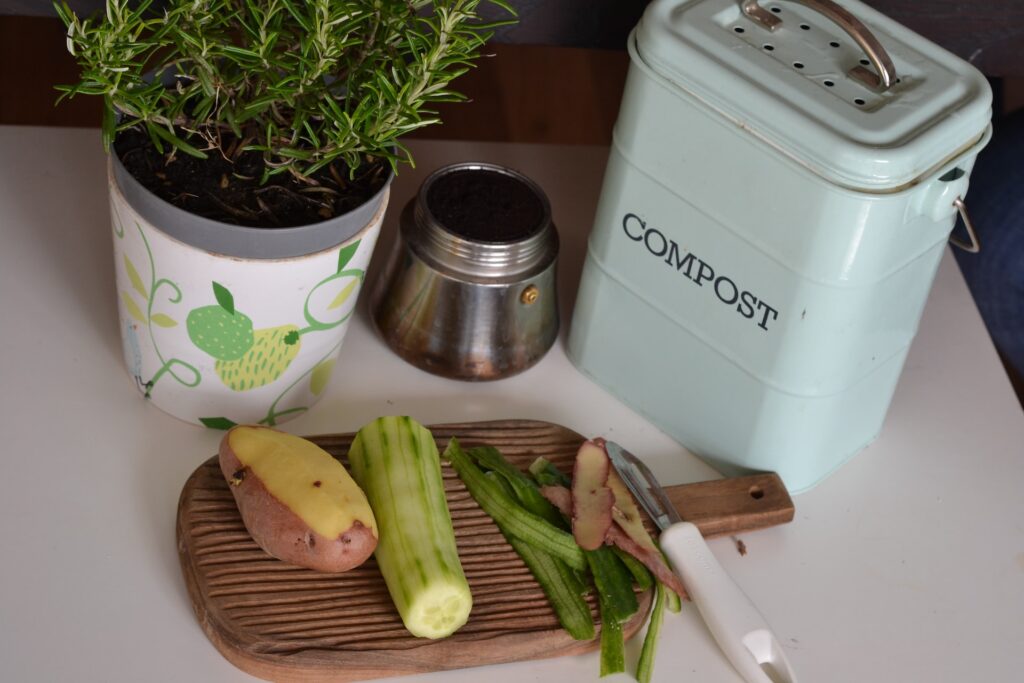
Photo by Lenka Dzurendova on Unsplash
The biggest step obviously comes from the biggest item though – make some stock from your turkey carcass! You’d normally need a pretty big pot for this, but odds are you already had some sort of roasting pan or metal tin you used to cook your bird in the first place, so use that as a substitute if you need to! As for how to make the stock there’s no shortage of recipes for you to use, but here we’ll just be linking to our favorite one from Serious Eats.
If you’d like to really “Wow!” your guests next year, put that stock in a zip-top bag or disposable container, and store it in your freezer (after it’s cooled completely) to use next year to make homemade turkey gravy for Thanksgiving!
The Lesser-Known Middle “R”
However you feel about the push for recycling and its 3 “R’s”, it’s hard to deny the effectiveness of the first two. We’ve already talked about reducing in this blog, so let’s make it a theme and move on to re-using!
This one is for the folks who are always on the move, who may not have time to spend a day prepping dinner and opt instead for to order their Thanksgiving feast. If your restaurant of choice sends you home with a collection of metal trays, potentially bigger than you, then you may find yourself looking for a use for all of them come cleanup time. If you’ve got the energy to wash them with the rest of your dishes, they can easily be reused for the next big meal you find yourself cooking. They can also make convenient storage for anything you might keep indoors or out, from plants to tools to even other pans!
If you get cranberry sauce or gravy that may come in a glass jar, you can very easily clean out those jars and reuse them for any other food storage. I suppose you could also reuse your metal cans of cranberry as mini planters, but you are better off just going to the 3rd “R” and recycle them.
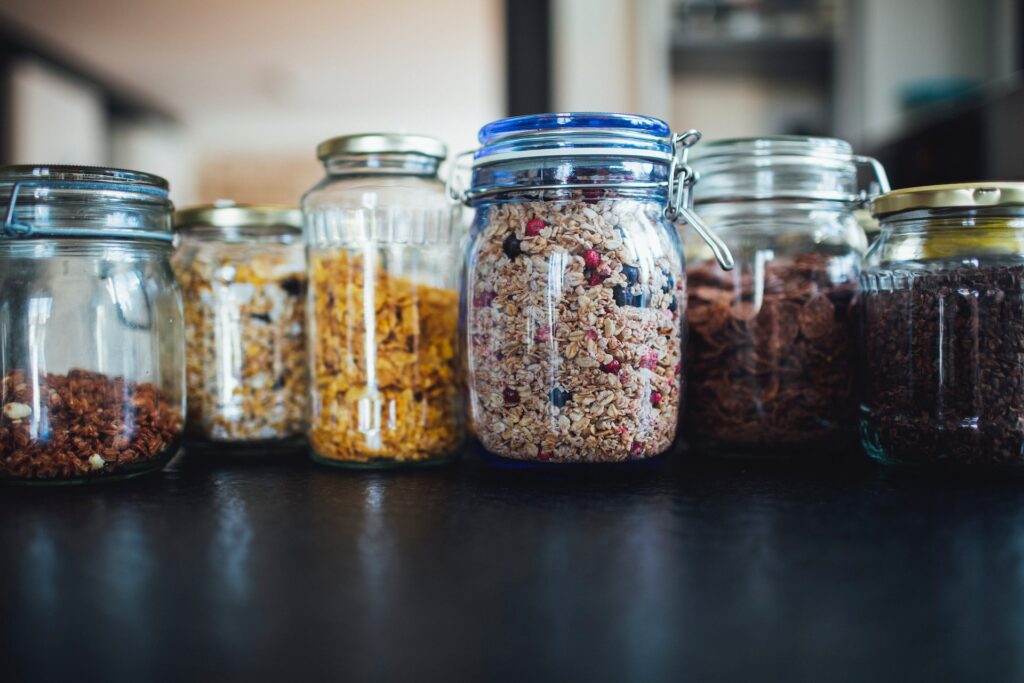
Photo by Markus Spiske on Unsplash
Shopping Local
Although shopping local may be difficult for those on a tight budget, it is something to consider as purchasing local products have a much smaller carbon footprint than items shipped or trucked to Long Island. On Long Island, you’ll find no shortage of local farmers with freshly grown produce and meat to serve at your Thanksgiving feast. These local farmers are inherently more sustainable options for buying your groceries for the mere fact that they won’t have to ship your produce across the country in a diesel truck or even across the ocean in a massive cargo ship, a fact that affects both organic and non-organic produce at the store. When shopping local, your food moves from the farm straight to your table essentially, cutting out the historically harmful middleman, and providing you and your family with higher quality food. This though will tend to come with an increased price point for your groceries. You could easily find yourself paying at least double, but potentially even more than what you will normally pay if you typically shop at budget supermarkets. Even so it’s hard to deny just how much of a difference shopping local can make when it comes to buying your produce and meat.

Photo by Graphic Node on Unsplash
Hopefully, this guide has inspired you to make some small, but impactful changes this holiday season. And whether you use these tips for this Thanksgiving or next, or any other food-centric holiday, we at the LIPBS hope you’ll enjoy the time spent, be it with family, friends, roommates, or just yourself and a warm blanket.
By: Andrew Wong, Long Island Pine Barrens Society
Cover Photo: Pro Church Media on Unsplash
Posted on November 18, 2022 by Long Island Pine Barrens Society
Gala 45 Wrap Up

What a month it’s been! If you’ve been following us online, you probably know that last week we had our 45th annual Environmental Gala! Did you know that the theme of our event was our new initiative, “The Best of The Rest?” If you missed the Gala, or maybe need a refresher on what The Best of The Rest is, check out last month’s blog post by clicking here.
The name seems like it’d be a bit of a giveaway, but a lot more went into our program than just a name. After all, we weren’t just pushing our new preservation effort, we were celebrating our entire history, and everything we’ve done wince 1979! This year, like last, we highlighted our Middle School Kids Go To College program, an educational initiative that connects local 6th graders with Stony Brook University (SBU). They participate in a special lecture from Dr. Christopher Gobler on water quality and pollution. This year and last these events were held online, much like our Gala, but you can still tune in and see the efforts of our hard-working students who were able to make projects that’s put even the most caffeine-crazed SBU freshman to shame.

Working to educate the next generation is one of the most important things we do, so that even in the future, its mission will be carried on by those with a passion for protecting the environment.
But that’s not all we did at our Gala. If you managed to tune in, you would’ve seen a special panel with four of our expert board members: Suzanne Ruggles, Tom Casey, John Turner, and Jennifer Garvey. In some patio chairs settled out in the Pine Barrens itself, the four of them held a panel discussing the importance of protecting the The Best of The Rest. Each board member discussed the function and importance of these parcels with their own field of expertise, leading to a panel that might be a lot to take in at first, but it showcases additional land needed to protect in the Pine Barrens.
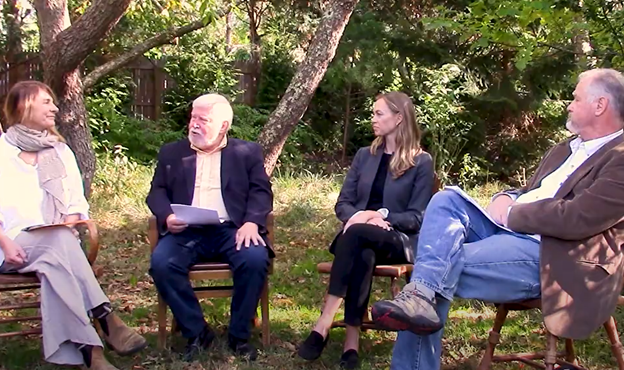
Speaking of our expert panel, regular viewers may remember John Turner and Suzanne Ruggles from our original announcement video for The Best of The Rest. In it, the two of them highlighted a number of the properties that were included in The Best of The Rest initiative, showing off the unique flora and fauna in each.
This time around, John Turner took the stage to do another presentation on the properties, highlighting again much of what he spoke about back in August, but also shedding light on topics not previously addressed. Much of his presentation remained on the fauna in each of the parcels, highlighting some of the endangered species which rely on said parcels for their habitats, and who would be most impacted by commercial developments. Beyond that, he discussed prior attempts by local governments to purchase some of the parcels for preservation, and the obstacles that ultimately stopped those attempts.

Failed attempts to preserve these parcels may be seen as a significant roadblock, but it could just as well be seen as a sign of the support that already existed for our initiative, long before we even had a name for it. Every failure and every obstacle we face in our preservation efforts is but another step toward achieving our goals.
The Best of The Rest is picking up steam, and we’re more than ready to continue pursuing our goal. We look forward to the day that we can say that the Pine Barrens in its entirety has been secured for future generations.
By Andrew Wong, Long Island Pine Barrens Society
Cover Photo: Julie Clark
Posted on October 24, 2022 by Long Island Pine Barrens Society
What is “The Best of The Rest”?

A little over a month ago, the Long Island Pine Barrens Society announced our newest initiative, The Best of The Rest. This important initiative seeks to preserve the remaining environmentally sensitive pine barrens parcels in the Core Preservation Area and Compatible Growth Area. In total these parcels make up 3,800 acres of land across Long Island! But maybe that isn’t the best explanation of what we’re doing, maybe an initiative this big deserves a little more background.

Governor Mario Cuomo signs the Pine Barrens Protection Act in 1993
Beginning with the original Pine Barrens Protection Act, the goal of the Long Island Pine Barrens Society had always been the preservation of land and drinking water. Also important is public education about this land. Making sure that people know that there was essentially one of the nation’s most beautiful nature preserves right in their backyard was just as important as preserving that land itself. And in 2019, the Long Island Pine Barrens Society declared victory on one of those fronts, with over 100,000 acres of land having been successfully preserved for future generations! By then, it had been a 42-year long battle to protect the Pine Barrens.
With Pine Barrens protection in place, it was important to promote opportunities for residents to appreciate the area. When the first wave of COVID-19 infections hit Long Island, the Long Island Pine Barrens Society put more focus into the recreational aspects of the Pine Barrens, and we released our family-friendly Parks Passport.
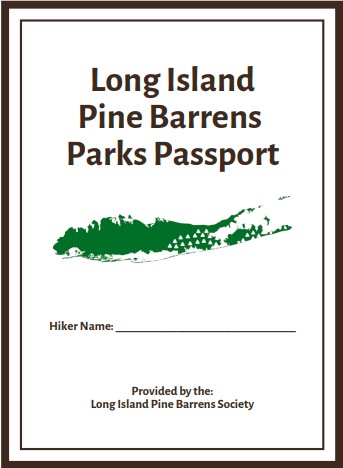
The LIPBS Parks Passport can be found at https://www.pinebarrens.org/wp-content/uploads/2021/05/Pine-Barrens-Parks-Passport-7.pdf
This comprehensive guide to Long Island Pine Barrens Parks compiled not only hiking trails, but lessons for families to complete together, encouraging them to venture out of the house while keeping safe in the early days of the pandemic.
At the same time, the Long Island Pine Barrens Society continued our long-standing battle with the Discovery Land Corporation over The Hills project in East Quogue, newly minted as the Lewis Road PRD. That particular fight became part of the basis for what would come next.
Enter The Best of The Rest initiative. I think by this point you have an idea of what that is, but I’ll take one more moment to explain. We at the Long Island Pine Barrens Society are pushing forward with our newest endeavor, to preserve 3,800 acres of land, the Rest, located in the Pine Barrens, the Best.
So, what about the land we’re trying to preserve? There are too many parcels to go over all of them here, but I will highlight a few of them here. If you were following our social media channels during the month of August, you probably saw us posting about three different parcels in three different townships. Those posts are still available to view as of now, but let’s go into a little more detail on some of them here.
Earlier in the blog I briefly mentioned the Lewis Road PRD, and how it came to be part of the push behind the Best of The Rest. The patch of land in East Quogue where the Discovery Land Company is seeking to develop their resort is one of the many parcels we’re seeking to preserve with The Best of The Rest. If you look through our old newsletters, in almost every single one for the last 13 or so years you’ll find a snippet about either Lewis Road or The Hills. Sometimes the blurbs would be counting a win for our preservation efforts, sometimes it’d be a win for the development. The fight with Discovery Land Corporation has been a long back and forth that’s ongoing, and as we approach some of the most decisive meetings with the Pine Barrens Commission and Town Board members, it’s more important than ever to maintain our resolve to protect that land.
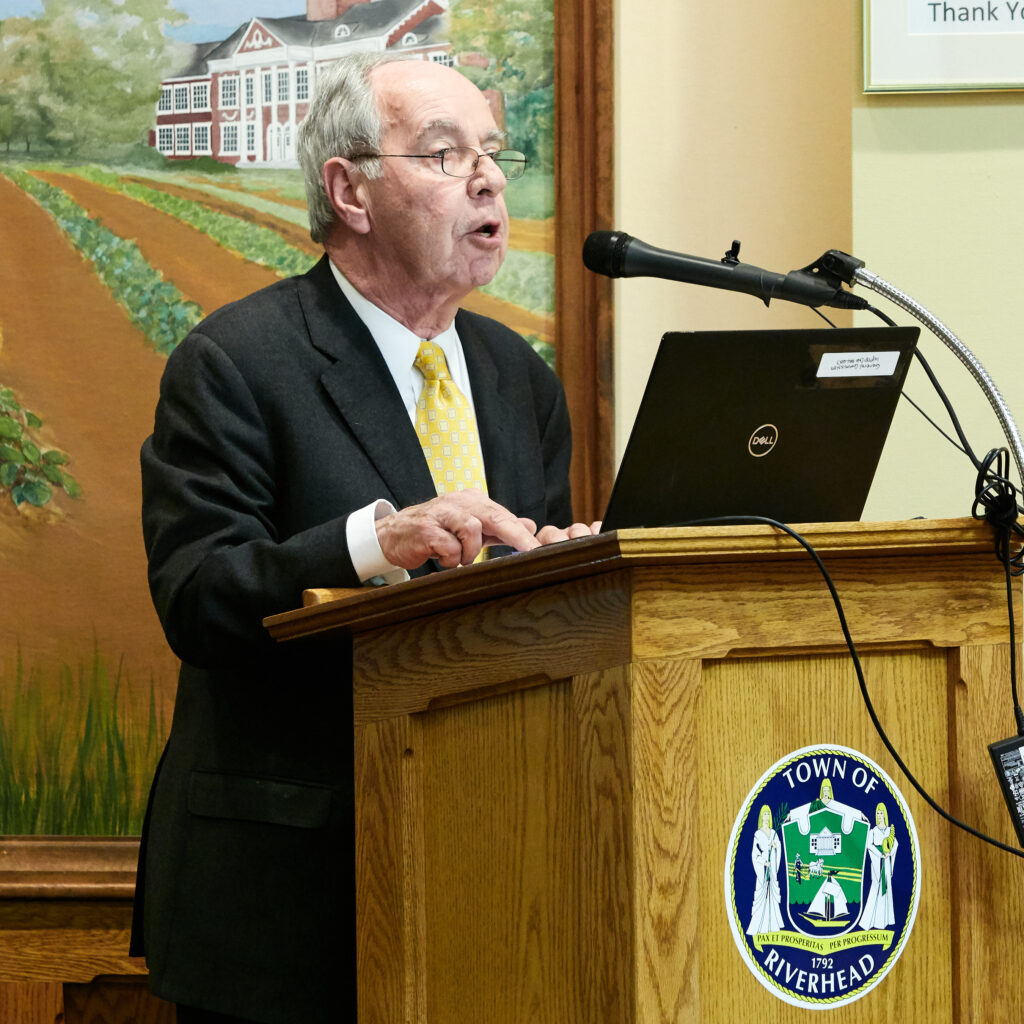
Dick Amper- Lewis Road Hearing 2/20
On a lighter note, during the early days of the pandemic, I mentioned that we’d created the Parks Passport, a fun way for families to venture into the Pine Barrens together and learn about Long Island’s most unique ecosystem. Not included in that family-oriented passport, for obvious reasons, was the over 125-mile long Paumanok Path, which stretches all the way from Rocky Point to Montauk Point. You could travel across just about all of Suffolk County without ever leaving public parkland on that trail! And while it’s certainly a marvel, and a must-try challenge for any serious hiking/camping enthusiasts, it’s still a very significant leap from the more casual trails around the Island.
That comes into play with some of the parcels we’re seeking to preserve in Suffolk County, including Shoreham beach and beyond. These parcels represent the final pieces in a roughly 16-mile-long jigsaw puzzle, that would create another trail, similar to the Paumanok Path. This new trail, freshly comprised of public park land, would create a single path reaching from Shoreham Beach, all the way down to Wertheim National Wildlife Refuge. Certainly not as massive as the Path, but regardless, a massive achievement, and what is bound to be a new challenge for recreational hikers looking to find something to brag about.
I’m not discussing just two parcels here; the Hills development site and 16-mile trail are made up of almost 20 individual parcels we’re looking to preserve. None of what we do at the Long Island Pine Barrens Society is simple, but all of it is important, not just for us, but those who will come after us.
To support these efforts, and to ensure that we can continue protecting Long Island’s most unique ecosystem well into the future, we’re hosting our annual environmental Gala on October 20, at 7:00PM EST this year. This time, the theme is all about the Best of The Rest initiative, and the steps we’ve taken this year to reach this point. As in recent years, we’ll be hosting our Gala online, livestreamed for all to see over Facebook and YouTube. That doesn’t mean we’re skimping on gifts for our supporters though; this year we’re offering a new “Party box” filled with specialty items all crafted right here on Long Island. Even if we can’t meet in person this year, we’d love to have you join us as we celebrate not only the past 45 years, but the future that The Best of The Rest hopes to preserve.
You can read more about The Best of The Rest here.
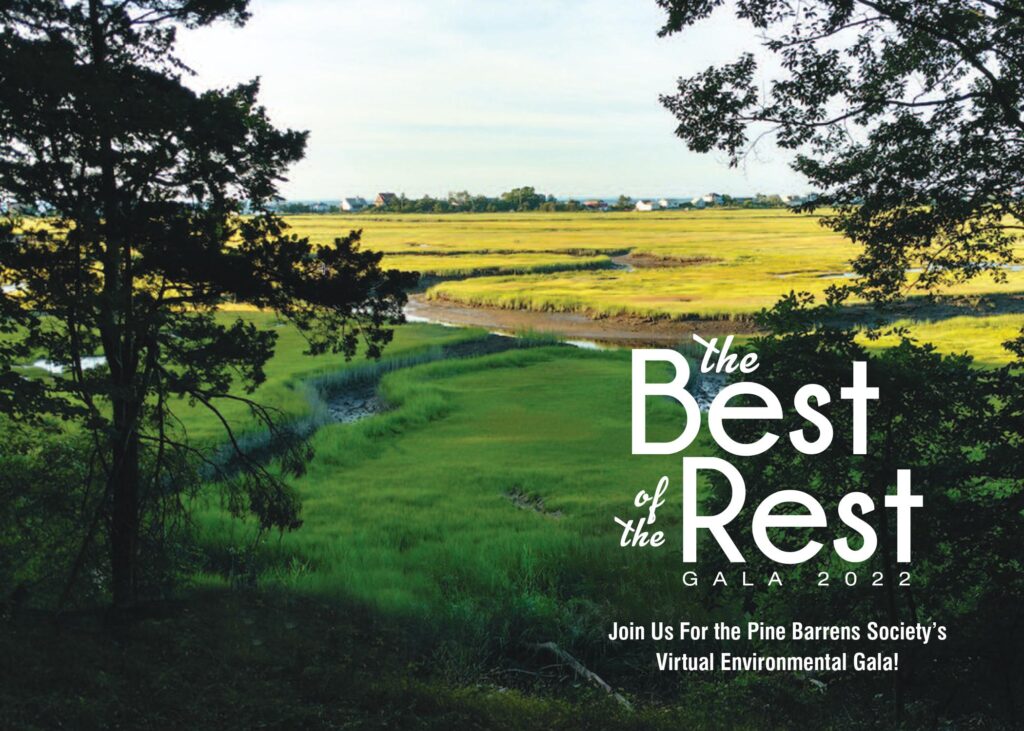
By Andrew Wong, Long Island Pine Barrens Society
Cover Photo: Julie Clark
Posted on September 20, 2022 by Long Island Pine Barrens Society

